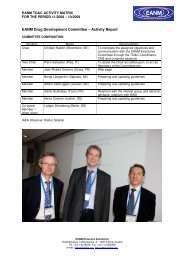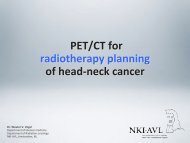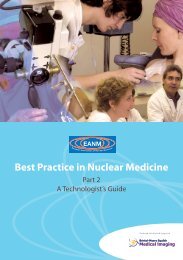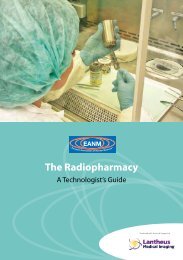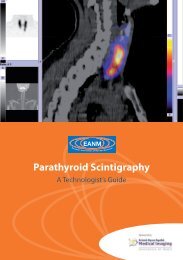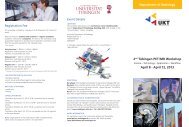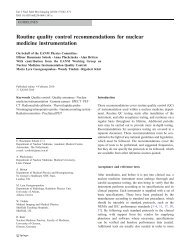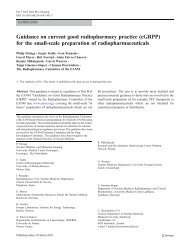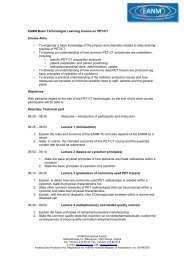Parathyroid Scintigraphy - European Association of Nuclear Medicine
Parathyroid Scintigraphy - European Association of Nuclear Medicine
Parathyroid Scintigraphy - European Association of Nuclear Medicine
You also want an ePaper? Increase the reach of your titles
YUMPU automatically turns print PDFs into web optimized ePapers that Google loves.
et al. 1996; Hindié et al. 2000; Mullan 2004)<br />
or 99m Tc-pertechnetate (Rubello et al. 2003)<br />
in addition to 99m Tc-sestamibi, improves the<br />
sensitivity for hyperplastic glands. One difficulty<br />
with subtraction imaging is keeping the<br />
patient still for the time necessary to scan the<br />
thyroid, to inject 99m Tc-sestamibi and to record<br />
images <strong>of</strong> this second tracer. Simultaneous<br />
recording <strong>of</strong> 123 I and 99m Tc-sestamibi can be a<br />
simple answer to these difficulties. It prevents<br />
artefacts on subtraction images due to patient<br />
motion, and shortens the imaging time<br />
(Hindié et al. 1998; Mullan 2004).<br />
Preoperative imaging has opened a new era<br />
<strong>of</strong> minimally invasive parathyroid surgery<br />
Conventional bilateral exploration is still<br />
considered the gold standard in parathyroid<br />
surgery. However, the introduction <strong>of</strong> 99m Tcsestamibi<br />
scanning, the availability <strong>of</strong> intraoperative<br />
adjuncts such as the gamma probe<br />
and intraoperative monitoring <strong>of</strong> PTH to help<br />
detect MGD have challenged the dogma <strong>of</strong><br />
routine bilateral exploration. When preoperative<br />
imaging points to a single well-defined<br />
focus, unequivocally suggesting a “solitary<br />
adenoma”, the surgeon may now choose focussed<br />
surgery instead <strong>of</strong> bilateral exploration.<br />
Focussed excision can be made by open surgery<br />
through a mini-incision, possibly under<br />
local anaesthesia, or by video-assisted endoscopic<br />
surgery under general anaesthesia (Lee<br />
and Inabnet 2005). Compared with patients<br />
who undergo bilateral surgery, those in whom<br />
focussed parathyroid surgery is successfully<br />
Chapter 1: Applications <strong>of</strong> parathyroid imaging<br />
completed enjoy a shorter operation time,<br />
the possibility <strong>of</strong> local anaesthesia, a better<br />
cosmetic scar, a less painful postoperative<br />
course, less pr<strong>of</strong>ound postoperative “transient”<br />
hypocalcaemia and an earlier return to normal<br />
activities. The fact that many clinicians now<br />
use a lower threshold for surgery is partly due<br />
to the perception that parathyroid surgery is<br />
easier than in the past (Utiger 1999).<br />
Patients at specific risk <strong>of</strong> failure <strong>of</strong> minimal<br />
surgery are those with unrecognised MGD.<br />
Therefore, when choosing minimal surgery,<br />
the surgeon is committed to distinguishing<br />
cases <strong>of</strong> MGD either preoperatively, through<br />
an appropriate imaging protocol, or by intraoperative<br />
monitoring <strong>of</strong> PTH plasma levels, or<br />
by a combination <strong>of</strong> both. The true sensitivity<br />
<strong>of</strong> intraoperative PTH for MGD is still under<br />
debate. What raises concern is that studies<br />
relying solely on intraoperative measurements<br />
report a low percentage <strong>of</strong> MGD, only 3% (Molinari<br />
et al. 1996), which is three to four times<br />
lower than is generally observed during routine<br />
bilateral surgery. Whether this will lead to<br />
higher rates <strong>of</strong> late recurrence is not known. It<br />
is thus important that imaging methods used<br />
to select patients for focussed surgery have a<br />
high sensitivity for detecting MGD.<br />
In this new era <strong>of</strong> focussed operations, the<br />
success <strong>of</strong> parathyroid surgery depends not<br />
only on an experienced surgeon but also on<br />
excellent interpretation <strong>of</strong> images. A localisation<br />
study with high accuracy is mandatory to<br />
EANM






